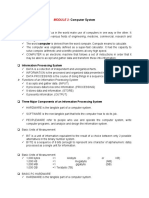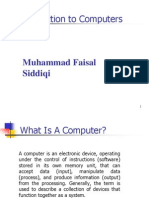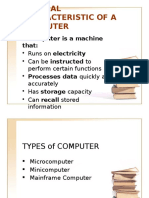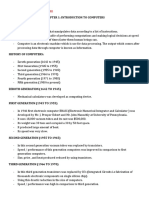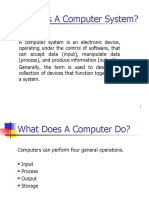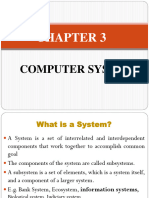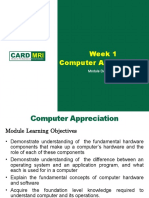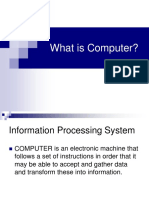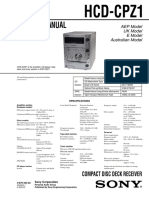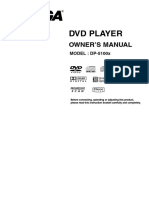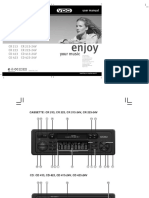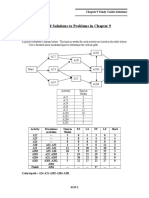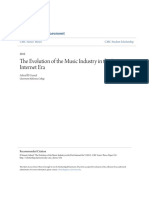Information Processing System
DATA is a collection of independent and
Computer Fundamentals
unorganized facts.
INFORMATION is the processed and
organized data presented in a meaningful
form.
DATA PROCESSING is the course of
Dr. Anoop Kumar Gupta doing things in a sequence of steps.
MAIT
1
Information Processing System
COMPUTER is an electronic machine that
follows a set of instructions in order that it
may be able to accept and gather data PROCESSING
and transform these into information. SYSTEM
DATA
INFORMATION
Functions of an Information Three Major Components of an
Processing System Information Processing System
1. It accepts and gather data. (INPUT) HARDWARE is the tangible part of a
2. It processes data to become information. computer system.
(PROCESSING) SOFTWARE is the non-tangible part that
3. It stores data and information. (STORE) tells the computer how to do its job.
4. It presents information. (OUTPUT) PEOPLEWARE refer to people who use
and operate the computer system, write
computer programs, and analyze and
design the information system.
Basic Units of Measurement Basic Units of Measurement
A byte can be used to represent a single
BIT is a unit of information equivalent to
character, which can be:
the result of a choice between only 2
A letter
possible alternatives in the binary number
A number
system.
A special character or symbol, or
BYTE is a sequence of 8 bits (enough to
A space
represent one character of alphanumeric
data) processed as a single unit for
information.
Basic Units of Measurement
1,000bytes =1 kilobyte (K or KB)
1,000 KB =1 megabyte (MB)
1,000 MB =1 gigabyte (GB)
1,000 GB =1 Terabyte (TB)
BASIC PC HARDWARE
HARDWARE is the tangible part of a
computer system.
Basic hardware of a PC system 1. Central Processing Unit
Central Processing Unit (CPU) Brain of the computer.
Memory Unit It directs and controls the entire computer
Input Devices system and performs all arithmetic and
Output Devices
logical operations.
Secondary Storage Devices
2. Memory Unit
Where the programs and
data are stored .
READ ONLY MEMORY
(ROM) contains the pre-
programmed computer
instructions such as the Basic
Input Output System (BIOS).
RANDOM ACCESS
MEMORY (RAM) is used to
store the programs and data
that you will run. Exists only
when there is power.
3. Input Devices Keyboard
Allows data and programs to be sent to
the CPU. Traditional keyboards
Keyboard Flexible keyboards
Mouse Ergonomic keyboards
Joystick Wireless keyboards
Microphone PDA keyboards
Webcam
Scanner
Monitor
Two Types of Mouse How a Mouse Hooks Up to a PC
Mechanical - a type of PS/2 Mouse
computer mouse that has a
rubber or metal ball on its
underside and it can roll in
every direction.
Optical: This type uses a Serial Mouse
laser for detecting the
mouse's movement. USB/Cordless Mouse
Other Pointing Devices Joystick – input device for
computer games
Trackball
Light Pens – light-
Track point sensitive penlike device
Touch pad Stylus – penlike device
commonly used with
tablet PCs and PDAs.
Touch Screen
Scanning Devices Image Capturing Devices
Optical scanners Digital Cameras
Card readers
Bar code readers
Character and mark recognition devices
Digital Video Cameras
4. Output Devices Types of Monitor
Media used by the computer in displaying Cathode Ray Tube (CRT)
its responses to our requests and
instructions.
Monitor
Liquid Crystal Display (LCD)
Audio Speakers
Printer
Dot matrix
Printers printer
IMPACT PRINTERS uses pressure by
physically striking the paper. Ex. Daisy
wheel printers, line printers, dot matrix
printers & band printers.
NON-IMPACT PRINTER does not apply
pressure on the paper but instead
produces character by using lasers, ink Inkjet printer
Laser
spray, photography or heat.
printer
5. Secondary Storage Devices Floppy Disk
Attached to the computer system to allow The most common secondary storage
you to store programs and data device
permanently for the purpose of retrieving 3.5” disk – 1.44MB
them for future use.
Floppy disk, Hard disk, CD Rom
High-Capacity Floppy Disks Hard Disk Drive or Hard Disk
Floppy disk cartridges Made of rigid materials unlike floppy disks
3 ½ inches in diameter Holds a greater amount of data
Stores more information
Zip disks
Optical Discs Kinds
A standard part of modern desktop Blue Ray Disk – 40G
machines, especially used for multimedia Digital Versatile Disk
purposes and preferred in loading DVD-R – write once, 3.95G
applications. DVD RW – rewritable, 3G
Single Layer and Double Layer
Compact Disk
CD-R– write once, 650MB
CD-RW – rewritable, 700MB
Optical Drives Other Secondary Storage
CD-ROM read CDs Solid-State Storage
CD-Writer read/write CDs No moving parts
DVD-Combo read/write CDs, read DVD Flash memory cards
DVD Writer read/write CDs
read/write DVDs
USB flash drives
Parts that Build Up A System Unit Casing or cover
Casing or cover Sound card The box or outer shell
Power Supply Floppy disk drive that houses most of the
Motherboard Hard disk drive computer, it is usually
one of the most
Microprocessor CD-ROM drive
overlooked parts of the
Memory MODEM PC.
Video Card Protects the computer
circuits, cooling and
system organization.
Power Supply Motherboard
The physical arrangement in a computer that
Responsible for powering every device in your
contains the computer’s basic circuitry and
computer.
components.
Parts of a Power supply:
Components are:
Disk drive connectors
Microprocessor
Motherboard connector
(Optional) Coprocessors
Power supply fan
Memory
Power switch
Basic Input/Output System (BIOS)
Input voltage selector
Expansion Slot
Cover
Interconnecting circuitry
Power plugs receptacle
Expansion Slots
Graphic cards
Sound cards
Modem cards
Network interface cards/network adapter
Software 2 Kinds of Software
1. System Software enables the application
Instructions that tell the computer how to software to interact with the computer
process data into the form you want. hardware.
Operating Systems are programs that coordinate
Software and programs are
computer resources, provide an interface between
interchangeable. users and the computer; and run applications.
Two major types: Utilities perform specific tasks related to managing
System and Applications computer resources.
Device drivers are specialized programs designed
to allow particular input or output devices to
communicate with the rest of the computer system.
Functions of a System Software 2 Kinds of Software
Managing resources (memory, processing, 2. Applications Software - provides the real
storage, and devices like printer). functionality of a computer. It help you
Providing user interface use your computer to do specific types of
Running applications
work.
Basic Applications, widely used in all career
areas.
Specialized Applications, more
narrowly focused on specific
disciplines and occupations.
Disk Operating System MS-DOS Commands
DOS was the first widely installed A COMMAND is the name of a special
operating system for personal computers. program that makes your computer carry
Command-driven out a task.
Graphical User Interface (GUI)
Thru GUI, users can interact directly with
the operating system.
Microsoft Windows
Icons, Menus, Dialog boxes
FILES EXTENSIONS
FILE is simply a collection of information Use extension to make your filenames
that you store on a disk or diskette. more descriptive.
Must have a unique name .DOC – word documents
Two parts: the filename and extension .XLS – excel documents
separated by a period. .PPT – powerpoint documents
RECIPE.DOC
DIRECTORIES
One way of organizing the files on your
computer Hard Disk
ROOT – one basic directory
Subdirectories







